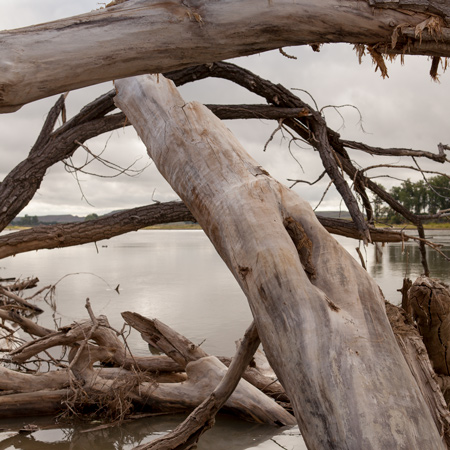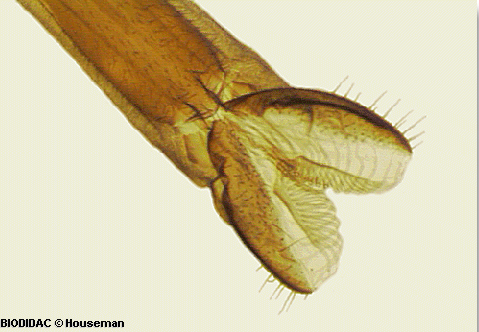Missouri and Yellowstone rivers, MT-ND Willard is swept away down the Missouri. At the mouth of the Yellowstone, Clark moves a few miles to escape the mosquitoes, while Pryor continues down the Yellowstone. In Philadelphia, curator Peale puzzles over Lewis’s pronghorn specimen.
Cottonwood Logs on the Missouri
© 26 July 2013 by Kristopher K. Townsend. Permission to use granted under the Creative Commons Attribution-Share Alike 4.0 International license.
More Mosquitoes[1]Originally aired weekdays by Yellowstone Public Radio during the Bicentennial observance of 2003-2006. Narrated by Hal Hansen. Scripts by Whit Hansen and Ed Jacobson. Produced by Leni Holliman. © … Continue reading
Willard Swept Away (Lewis)
An Early Start
Set out at 4 A. M. this morning. at 3 P. M. we arrived at the entrance of Milk river where we halted a few minutes. during our halt we killed a very large rattlesnake of the speceis common to our country.
—Meriwether Lewis
Sawyer Snags Willard
I and Willard went on eairly with a Small canoe to hunt we procd . . . . about 11 oClock at night we found ourselves in a thick place of Sawyers as the corrent drawed us in and we had no chance to git out of them So we run about half way through and the Stern run under a limb of a tree and caught Willard who was in the Stern and drew him out as the current was verry rapid.
—John Ordway
Steering from the Bow
I being in the bow of the canoe took my oar and halled the bow first one way and the other So as to clear the Sawyers and run through Safe and paddled the canoe to Shore and ran up the Shore opposite Willard & he called to me if everry thing was Safe I told him yes but he could not hear me as the water roared past the Sawyers.
—John Ordway
Saving Private Willard
he had made a little raft of 2 Small Sticks he caught floating and tyed them together, and tyed his cloathes on them and would Swim down through this difficult place and I run down and took out the canoe and took him in as he Swam through Safe we procd.
—John Ordway
Microscope slide of the tip of the labellar lobes, or lips, of a Culex’s mouthparts, at the business end of a mosquito’s proboscis (Greek pro, “in front;” boscis, “to feed”). Could Meriwether Lewis have imagined such a sensuous detail?
More Mosquitoes (Clark)
A Note for Lewis
I ordered the Canoes to be reloaded with our baggage & dryed meat which had been Saved on the Rochejhone together with the Elk killed at this place. wrote a note to Capt Lewis informing him of my intentions and tied it to a pole which I had Stuck up in the point. At 5 P. M Set out and proceeded on down
—William Clark
Jean Baptiste’s Swollen Face
he Child of Shabono [Jean Baptiste Charbonneau] has been So much bitten by the Musquetor that his face is much puffed up & Swelled. I encamped on this extensive Sand bar which is on the N W. Side.
—William Clark
Mosquito Remedy
our best retreat from those insects is on the Sand bars in the river and even those Situations are only clear of them when the Wind Should happen to blow which it did to day for a fiew hours in the middle of the day. the evening nights and mornings they are almost indureable perticelarly by the party with me who have no Bears to keep them off at night, and nothing to Screen them but their blankets which are worn and have maney holes.
—William Clark
Rapids and High Waves (Pryor)
he [Nathaniel Pryor] informed me that they passed through the worst parts of the rapids & Shoals in the [Yellowstone] river without takeing a drop of water, and waves raised from the hardest winds dose not effect them.
—William Clark (recorded 8 August 1806)[2]Precise dates and locations for Pryor’s trip down the Yellowstone are not known. Pryor was instructed to keep a journal, but it if he did, it is lost.
Weather Diaries
State of the weather at rise
Wind at rise
State of the weather at 4 P. M. Wind at 4 P. M. fair S E fair S E —Meriwether Lewis
State of the weather at Sun rise State of wind at Sunrise State of the weather at 4 P. M. Wind at 4 P. M. State of river N W. fair N E fall 6 ½ in. Rochejhone falling much faster than the Missouri
—William Clark[3]To assist the reader of this web page, the date column is not presented, some abbreviations have been spelled out, and the three river columns have been merged.
Naming the “Antelope”
Museum July i. e. Aug. 4th. 1806.
Dear Sir [Thomas Jefferson]
I presented to the [American] Philosophical Society at their last setting, the drawing of the Antilope [pronghorn] with a short description of it, “done from a specimen in my Museum, which was sent from the interior of Louisana by Captn. Lewis, and presented to the Museum by the President in Octr. 1805” A member demanded of me, what name I gave it? to which, after a few moments reflection, I replyed The forked Horned Antilope. but Sir that is not a scientific name. It is not a Lattin Name but one most descriptive of the Animal, since we knew of no Antilope besides having forked Horns. this was admitted as true. As men pretending to a knowledge must be humoured with the high sounding names made from the dead Languages, I most humbly request of you my dear Sir, to give me a Name for this American Antilope, perhaps the Indian Name, if it could be had would be a proper one. however I leave it to your superior judgement, and shall only say that whatever you think proper to give it, will be placed in print on the Animal in the Museum . . . .
C W Peale[4]Founders Online, National Archives, founders.archives.gov/documents/Jefferson/99-01-02-4127 [Originally from The Papers of Thomas Jefferson]. Jackson incorrectly gives the date of this letter as 4 … Continue reading
Notes
| ↑1 | Originally aired weekdays by Yellowstone Public Radio during the Bicentennial observance of 2003-2006. Narrated by Hal Hansen. Scripts by Whit Hansen and Ed Jacobson. Produced by Leni Holliman. © 2003 by Yellowstone Public Radio. |
|---|---|
| ↑2 | Precise dates and locations for Pryor’s trip down the Yellowstone are not known. Pryor was instructed to keep a journal, but it if he did, it is lost. |
| ↑3 | To assist the reader of this web page, the date column is not presented, some abbreviations have been spelled out, and the three river columns have been merged. |
| ↑4 | Founders Online, National Archives, founders.archives.gov/documents/Jefferson/99-01-02-4127 [Originally from The Papers of Thomas Jefferson]. Jackson incorrectly gives the date of this letter as 4 July 1806 in Letters of the Lewis and Clark Expedition with Related Documents: 1783–1854, 2nd ed., ed. Donald Jackson (Urbana: University of Illinois Press, 1978), 308–09. |


